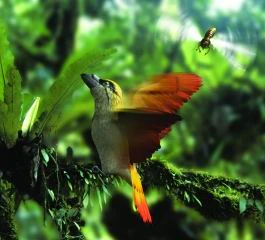
A spitfire bird hovers about a spitfire tree, unaware of the approaching danger. Behind it is a falconfly, zooming in for an attack.
The spitfire bird is a poisonous flutterbird that lives in the Antarctic Tropical Rainforest in the documentary The Future is Wild. It has developed a truly impressive defensive strategy against enemies such as the falconfly.
The spitfire bird is slightly bigger than the roachcutter, with bright orange flashes on its wings, and can often be seen hovering in front of a spitfire tree. It dips its head repeatedly into the flower from which it appears to be feeding. Suddenly, there may be a hum and flutter as the other residents of the forest canopy flee an approaching predator. But rather than darting away to safety, this bird faces the danger. As the predator draws near, the spitfire bird will lower its head. Then, at the last possible moment, it sprays a hot, corrosive acid from its nostrils.
The spitfire bird does not actually feed from the spitfire tree flowers, but gather chemicals from them. Like its cousin the roachcutter, the spitfire bird actually feeds on small arthropods. The flower that it is particularly interested in is always that of the spitfire tree. The male and female of this type of tree produce different chemicals. Both are harvested by the spitfire bird and stored in a compartment of its throat, known as the crop. When faced with danger, the bird releases the chemicals, mixing them in a chamber in its nasal cavity and adding an enzyme from a gland in its skull. The enzyme unbinds the chemicals, which react violently with each other to produce the corrosive acid. The spitfire tree also benefits from the spitfire bird's plundering of its resources. As it hovers between the male and female trees, dipping its beak into their flowers, the bird aids pollination.
The closely related false spitfire bird mimics the appearance of a true spitfire bird to protect itself from attackers.
However, a spitfire bird can sometimes be fooled by a gang of four spitfire beetles pretending to be a spitfire tree flower. This sometimes works for the beetles and other predators, because spitfire birds only visit the spitfire tree flowers when they run out of chemicals.
|
|||||||||
